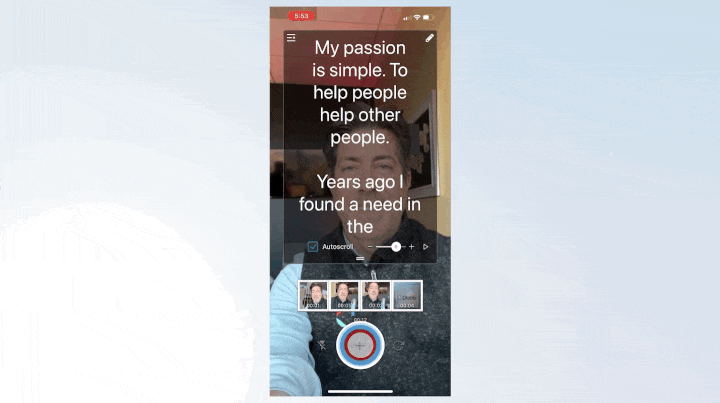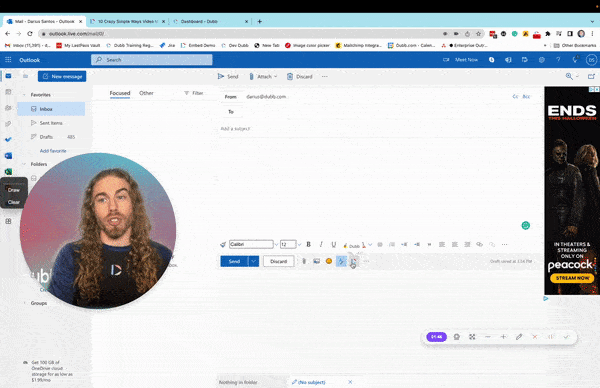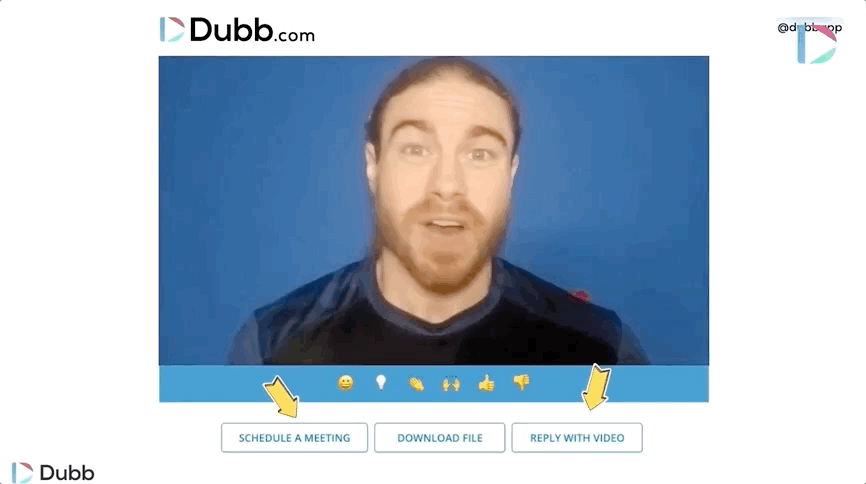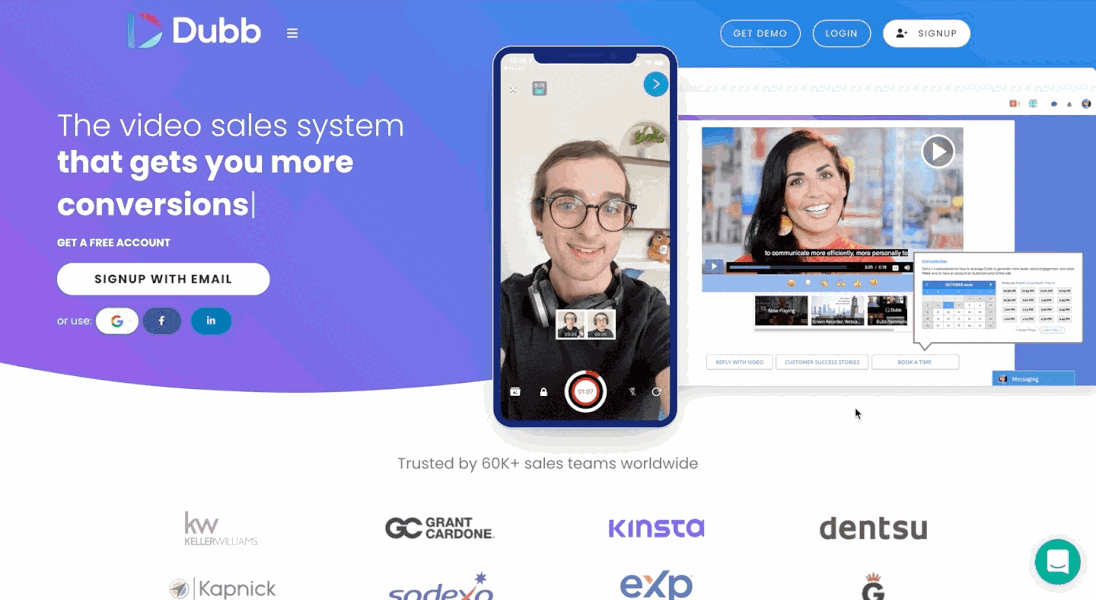Video email marketing is an extremely important strategy for salespeople and marketers alike.
Having said this, it can be difficult to understand some of the nuances and best practices of video email marketing. From creating content to getting it into the hands of your audience members, there are many moving parts here.
If you are looking for a guide, you are in the right place. In this post, I want to take a deep dive into video email marketing. We are going to discuss everything from the power of video emails to how you can track the performance of your videos. Whether you are a brand new marketer or are looking to use video email marketing to help you reach your goals, you can rely on the tips and tricks in this post to get more done.
Table of Contents
Some Key Foundational Principles
The Power of Video Emails
Best Practices in Video Email Marketing
Don’t Attach Videos to Your Emails
Creating Your Videos
Rely on Animated GIFs and Video Landing Pages
Leverage Calls to Action
Use the Word “Video” In Your Subject Line
Track Your Video Emails
Advancing on Your Video Email Marketing Journey
Some Key Foundational Principles
Whenever we talk about marketing, we start from several foundational first principles. I would argue that the definition of marketing is somebody (whether an individual or company) selling a product or service to someone else.
As you may have heard, there are four “P’s” of marketing. They are product, price, place, and promotion. These four P’s have guided marketers as they engage with customers and leads. Whether they do so in-person, online, or a combination of both, these four P’s can steer marketers in the right direction as they work to accomplish their goals.
At the same time, I think that there is one “P” that is missing. That “P’ is people and I would argue that it is the most important “P.”
At the end of the day, people are most important. It is about making connections with individual people and catering to their wants, needs, and desires. While everyone is different, we have this unifying desire to have others care about us. If other people can truly care about our wants, needs, and desires, we are much more likely to develop long-term relationships with them.
If you are able to make these connections, you are much more likely to make a sale and build a durable, long-lasting relationship. On the other hand, if you focus more on making the sale or hitting a certain sales or marketing quota, it’s going to be much tougher to get that sale and create a relationship.
The choice is clear. However, when we actually go about and try to create strong relationships, we find that it is easier said than done.
The Power of Video Emails
With that, let’s talk about email. We have all been using email for years now. It has become a quintessential part of our lives. Whether we are responding to work messages or trying to coordinate a dinner with friends, we are probably using email to some extent.
In the marketing context, email is one of the earliest and most effective forms of marketing out there. The statistics are eye opening. For instance, around 77% of marketers have seen increases in email engagement over the past year. Email marketing revenue is expected to reach a whopping $11 billion by the end of this year. No matter what type of business you run or work for, email marketing is likely a viable option.
However, you can go one step further. You can send video emails.
But let’s take one step back. The reality is that when some people receive emails, they glaze over the text. It is much more difficult to make a human connection with the person who wrote or composed the message.
This is especially true in this new era of artificial intelligence. Now, AI can do much of the writing for us, but the recipient on the other end doesn’t necessarily know if it is real or not. Granted, there are some signs that make it slightly easier to identify. For instance, AI tools like ChatGPT tend to use the words “unlock” and “unleash” pretty regularly. Ultimately, the more salesy that the email message becomes (whether written by AI or a human), the more likely that it won’t connect with the reader.
So what is the solution to this? I think that it comes from the power of video.
Video emails are so powerful because they can form that human connection. They make it much easier for you to show who you are, what your company is about, and how you can provide value to the viewer. Moreover, our brains are naturally attracted to video. Studies have shown that the human brain processes images 60,000 times faster than text. Along with the immense storytelling ability that video has to offer, you have an extremely engaging medium that your audience likely prefers.
In the end, video emails let you get the best of both worlds. You get the ubiquity of email with the engagement and appeal of video. By sending video emails to your audience members, you drastically increase the chances of improving your brand power and making more sales.
Best Practices in Video Email Marketing
Now that we touched on why video emails are so powerful, I want to take another step forward and speak about some best practices in video email marketing. Sure, you may have your own marketing objectives and goals. Your business may be different from the average business. That said, I believe that these best practices can really supercharge your video email marketing work.
We aren’t going to go over every best practice here. There are undoubtedly more. But by following these tips and pieces of advice, you will be in a fantastic position to move forward.
Let’s jump into it.
Don’t Attach Videos to Your Emails
This is the first best practice because it is so important. When you are thinking about video email marketing, it’s natural to think that you do so by attaching your video to an email. Once you have created an amazing marketing video, you may want to attach it to your email message and send it along.
There is a major problem with this strategy. There is a good chance that your audience members won’t see your email and video. It comes down to the fact that email providers may end up blocking your email or diverting it into spam. Video attachments can be quite large so size limits may prevent your email from getting through.
Ultimately, there are too many red flags when attaching your video to an email. It’s better to forego this idea and do something else (which leads us to our next best practice).
Creating Your Videos
Now, let’s talk about how you can actually create your video emails. This deserves its own blog post, but there are a few key things to keep in mind here.
First, make sure that your video has a strong message. This doesn’t need to be a “salesy” message or a message that is overwhelmingly focused on having a prospect turn into a paying customer. But at the same time, being clear about the value you are offering the viewer is critical.
Simply put, you do not want to waste their time. Make sure that your video emails contain some type of value, whether that is industry news, how to better use your product or service, or something else. Even funny, entertaining videos can provide value. No matter how you do it, make sure that you are leading with value and a strong message.
Next, prioritize story. Above, I mentioned how video is a fantastic way to share stories with virtually any type of audience. It’s critical to tap into this attribute when you are creating video emails.
Once again, your creativity is your only limit here. You can tell stories about virtually anything and your audience will love you for it. Better yet, take your audience members on a little journey. Feel free to add some conflict. Provide solutions to the problem and, if it makes sense, talk about how your product or service can make the audience members’ lives better.
This is more art than science, but you are miles ahead by keeping story at the top of your mind. Don’t forget it.
From story, I encourage you to write a script. This may not seem like the most obvious best practice. After all, if you look at sales and marketing videos (particularly selfie videos), it may seem like the speaker is speaking off the cuff to the camera. While that may be true in some situations, the truth is that having a script makes your job much easier.
Creating a script is helpful both in the pre-production process and as you are recording. In the pre-production process, settling on a script can help you gather your thoughts. It also ensures that you are saying what you want to say in your marketing video. And when you are actually recording your video, having a script can keep you organized and on point.
Now, there are several ways to actually do this. For instance, you can use Dubb to create your script. Using Dubb’s artificial intelligence tool called IRA, you can quickly create a script that suits your specific needs. From there, you can use Dubb’s teleprompter tool to have your script appear as you are recording. It’s a fantastic way to both record content and ensure that you are delivering everything that you want.

If you get started with just these best practices, you’ll be on your way to creating stellar video content. From there, keep experimenting and making new videos. You will make tremendous progress in one week, one month, and certainly one year from now.
Rely on Animated GIFs and Video Landing Pages
I believe that this is the best way to send video emails and execute your video email marketing strategy. It not only ensures that your video will be delivered, but it will help you increase your open and view rates.
What you want to do is record your video. You can do this however you’d like (including within the Dubb ecosystem). Once you have your video and upload it to a tool like Dubb, you can automatically get a three second GIF of your video. That GIF is from the first three seconds of the video, meaning that you can really entice the viewer to click on it by including their name in the GIF.

However you choose to do it, pasting this GIF into the body of your email can really be a game changer. It not only entices the recipient to click on the link and watch your video, but it won’t get blocked by email clients. You can be sure that the video will get into the hands of your recipients. From there, you have a much better chance of your video actually being watched.
But this naturally leads to the question of what happens when a recipient clicks on the animated GIF. Ultimately, the recipient is led to a video landing page.
You can think of video landing pages as central hubs for each of your videos. They are the infrastructure for an entire video email marketing campaign. If you are a Dubb user, for instance, you automatically get a Dubb landing page for each of your videos.
Video landing pages are amazing things because they are designed to help you move your viewers down your sales and marketing funnels. In effect, they help you move your prospects from point A to point B.
Video landing pages are so special because they can be customized in so many different ways. For instance, if you are a Dubb user, you automatically get a Dubb landing page for each of your videos. You also get to include your logo and custom brand colors. You can be confident that every single one of your video landing pages will look the way that you want them to look. Better yet, once you set a template design, that design is automatically applied. Pretty great, right?
But beyond sheer appearance, video landing pages offer a huge benefit to sales professionals and marketers like you. Ultimately, they let you include call to action buttons below your videos.
Leverage Calls to Action
These call to action buttons are so important that I wanted to include a separate section on them here. They are a critical part of achieving success with video email marketing.
If you haven’t yet heard of calls to action, they are essentially ways to get people to do something. They inspire action after the audience member reads a blog post, listens to a podcast, watches or video, or does something else. Really, it represents anything that you define as a conversion.
In the context of video landing pages, you can use a tool like Dubb to include call to action buttons right below your video. They look like this:

As if the news couldn’t get better, the great thing about call to action buttons is that they are so flexible. You can program them in virtually any way that you’d like. For instance, some of the many call to action options that you can leverage include the following:
- Scheduling a call on your calendar: You can easily embed your calendar on a video landing page. From there, your audience members can watch your video, see when you are available to take a call, and directly schedule a time on your calendar. It’s a fantastic way to find new leads—even when you are sleeping.
- Complete a form: This is a great call to action for prospects or leads who are just hearing about your business. Once the viewer watches your video, they can quickly complete a form (perhaps to receive an ebook or other lead magnet that you offer). You can then use this information to better engage with your viewers as they learn about you and your company.
- Watch another video: You can also think of this as a playlist feature. Essentially, what happens is that your viewer watches your first video and is then invited to watch more videos. In some circumstances, the next video in the playlist will start playing automatically. This is a great way to introduce your viewer to your company. For example, you can create a hyper-personalized video for the main video and then include a more general video in the playlist. The choice is yours.
- Reply with video: This is one of my favorite call to action options. Basically, it is a button that, once clicked, allows the viewer to record a video of their own and send it back to you. It’s an easy way for your viewers to react to your initial video and to get in touch. In other instances, your viewer can use the reply with video feature to record a video testimonial for your company. Video testimonials are fantastic ways to leverage social proof and show prospects how satisfied paying customers are.
- Visit a website: This is one of the more flexible call to action options. Here, you can program a call to action button to direct your viewer anywhere you want. It can be everything from your company’s website to a blog post that you have written.
- Make a purchase: Finally, this is a call to action option that we can all love. You can program a button to take the viewer to a purchase page. This is a more obvious option for individuals at the bottom of your sales and marketing funnels, but you can use this option wherever you’d like.
These are just some of the call to action options that you can use on your video landing pages. No matter which ones you choose, I highly encourage you to use at least some for all of your videos. In all likelihood, you’ll be happy with the results.
Use the Word “Video” In Your Subject Line
This is a quick and easy best practice that can help you increase your open rates.
Essentially, what you want to do here is use the word “video” in the subject line of your video emails. It is much better to include it at the beginning of your subject line, but it can be at the end as well.
As you can guess, including the word “video” in the subject line makes it obvious that you are sending a video to that user. And since individuals are naturally attracted to video, it makes it more likely that they will actually open the email and consume your content.
I like to think of it like this. Video equals curiosity and curiosity equals engagement. Engagement leads to interest, interest leads to decision-making, and decision-making leads to sales. Using the word “video” (and including a compelling video in your email) sparks this entire process.
Track Your Video Emails
Finally, let’s talk about tracking. Whenever you are creating digital content, you will want to track the performance of that content. Tracking gives you a pretty objective look at how your audience is engaging with your content. With that data in mind, you will want to double down on what is working and avoid what isn’t working.
There are several ways that you can leverage tracking in your video email marketing work. For starters, you can add a retargeting pixel on your video landing pages. We have seen Dubb users successfully do this. Even if you aren’t technical, this is a quick and easy way to get more data about who is visiting your video landing pages.
Besides retargeting pixels, I encourage you to set up some KPIs and track the performance of your large campaigns. If you are broadcasting a video email campaign to a large email list, you can get a wealth of data. So long as you set it up correctly, you can see who opened your emails, who clicked on call to action buttons, how much of a video that your audience members watched, and more.
Based on all of this information, you can pursue additional touchpoints to convert your interested prospects into paying customers. It is often said that there need to be 12 to 18 touchpoints to make a conversion. Why not leverage data, automation, and tracking to help you close the gap?
On Dubb, for instance, you can get granular data about how individual prospects are interacting with your content. You can view metrics like the percentage of videos watched, the number of call to action buttons clicked, and more.

No matter what video email marketing platform you use, make sure that you are tracking your content. While many of us focus on creating digital content, few of us actually look at how that content is performing. By taking time on the latter, you will be in a fantastic position to reach your marketing goals.
Advancing on Your Video Email Marketing Journey
Ultimately, there is a funnel of video email marketing. It starts with the email subject line (which should include the word “video”). After that, it includes your email, which should have a hook in the first sentence. From there, you can include the email’s value proposition, a call to action for the end user to watch the video, and then an animated GIF that shares the first three seconds of your video.

However you decide to do your video email marketing work, I urge you to make video a priority. Remember that at the end of the day, your goal as a marketer is to build a human connection. Your goal is to build trust, make an impact, and drive conversions. Video can help you with all of these things. All it takes is for you and your team to leverage these tools to reach your goals.
Finally, I encourage you to check out Dubb. Dubb is a video communications platform that can help you with not only video email marketing, but all of your sales and marketing needs. From plenty of creation tools (including the Dubb mobile app and Dubb desktop app) to plenty of AI tools and assistants, Dubb is your one stop shop for all of your sales and marketing work.
If you would like to learn more about Dubb, click here. You can also click here to get a free 14-day trial of our premium plans.


